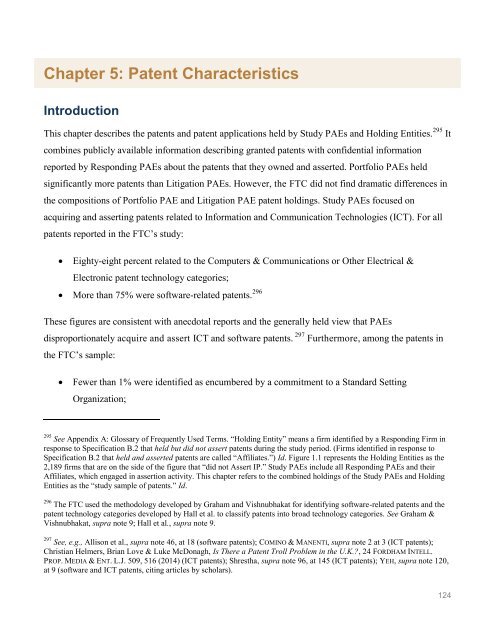Create successful ePaper yourself
Turn your PDF publications into a flip-book with our unique Google optimized e-Paper software.
Chapter 5: <strong>Patent</strong> Characteristics<br />
Introduction<br />
This chapter describes the patents and patent applications held by Study PAEs and Holding Entities. 295 It<br />
combines publicly available information describing granted patents with confidential information<br />
reported by Responding PAEs about the patents that they owned and asserted. Portfolio PAEs held<br />
significantly more patents than Litigation PAEs. However, the FTC did not find dramatic differences in<br />
the compositions of Portfolio PAE and Litigation PAE patent holdings. Study PAEs focused on<br />
acquiring and asserting patents related to Information and Communication Technologies (ICT). For all<br />
patents reported in the FTC’s study:<br />
<br />
<br />
Eighty-eight percent related to the Computers & Communications or Other Electrical &<br />
Electronic patent technology categories; <br />
More than 75% were software-related patents. 296<br />
These figures are consistent with anecdotal reports and the generally held view that PAEs<br />
disproportionately acquire and assert ICT and software patents. 297 Furthermore, among the patents in<br />
the FTC’s sample:<br />
<br />
Fewer than 1% were identified as encumbered by a commitment to a Standard Setting<br />
Organization; <br />
295<br />
See Appendix A: Glossary of Frequently Used Terms. “Holding <strong>Entity</strong>” means a firm identified by a Responding Firm in<br />
response to Specification B.2 that held but did not assert patents during the study period. (Firms identified in response to<br />
Specification B.2 that held and asserted patents are called “Affiliates.”) Id. Figure 1.1 represents the Holding Entities as the<br />
2,189 firms that are on the side of the figure that “did not Assert IP.” Study PAEs include all Responding PAEs and their<br />
Affiliates, which engaged in assertion activity. This chapter refers to the combined holdings of the Study PAEs and Holding<br />
Entities as the “study sample of patents.” Id.<br />
296<br />
The FTC used the methodology developed by Graham and Vishnubhakat for identifying software-related patents and the<br />
patent technology categories developed by Hall et al. to classify patents into broad technology categories. See Graham &<br />
Vishnubhakat, supra note 9; Hall et al., supra note 9.<br />
297<br />
See, e.g., Allison et al., supra note 46, at 18 (software patents); COMINO & MANENTI, supra note 2 at 3 (ICT patents);<br />
Christian Helmers, Brian Love & Luke McDonagh, Is There a <strong>Patent</strong> Troll Problem in the U.K.?, 24 FORDHAM INTELL.<br />
PROP. MEDIA & ENT. L.J. 509, 516 (2014) (ICT patents); Shrestha, supra note 96, at 145 (ICT patents); YEH, supra note 120,<br />
at 9 (software and ICT patents, citing articles by scholars).<br />
124


